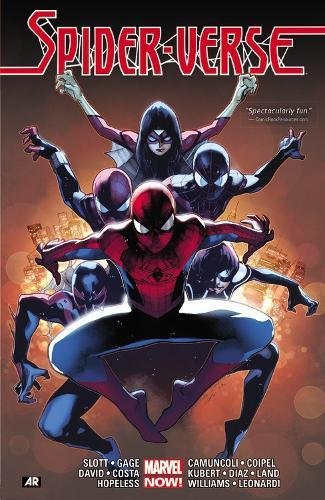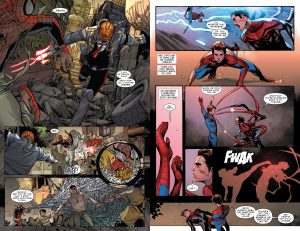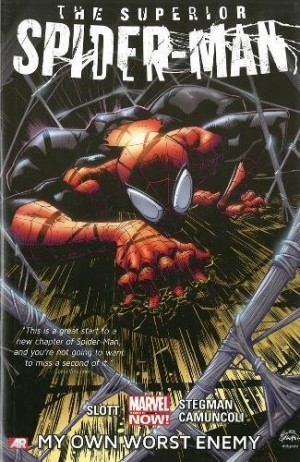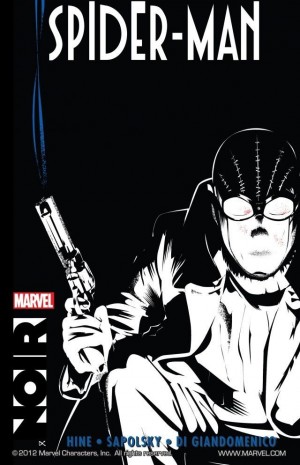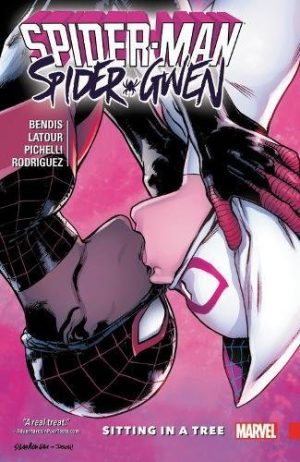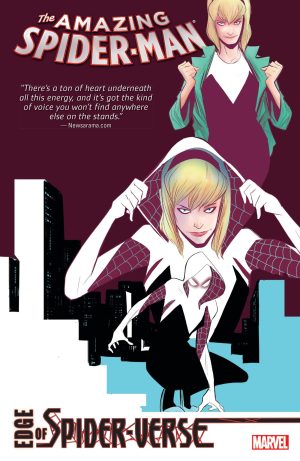Review by Ian Keogh
This is one monster graphic novel, clocking in at almost 650 pages and seemingly with one massive inbuilt flaw. The content is arranged by series rather than publication order and when it involves seven series, four of them launched to tie-in with the plot, the potential for confusion is great. Marvel provide a suggested reading order, so why not just print the stories in that order instead? That might be logical, but the story’s well structured and works via either method, so the choice is to read as published, or plaster the book with book marks and follow Marvel’s suggested reading order.
Editorially, someone has thought it would be nifty to present a story uniting all the variations of Spider-Man introduced over the years, and they’re right about that. Marvel have even created new iterations, some just to serve as cannon fodder, others like Spider-Gwen designed for the long term. Going back the other way, the research has been deep and it’s a real expert who’ll be able to spot missing Spider-Men, although anyone who grew up loving Spider-Man and his Amazing Friends should avoid Spider-Verse.
Events are prompted by the implacable Morlun being but one of a race called the Inheritors, near invincible and able to track down and murder Spider-Man in every alternate universe. Some Spider-Men discover this early, primarily the Superior Spider-Man, who gathers an entire squad of spider allies. Spider-Verse is well structured if following the suggested reading order. It’s not a linear story, but one where several smaller battles eventually feed into the bigger picture, which is why Spider-Verse also works following the pagination, although that way the actual story finishes at the halfway point, while the remaining content fills in some background.
It helps the consistency greatly that the majority of the core story is drawn by either Giuseppe Camuncoli or Olivier Coipel. Coipel has the slightly more elaborate approach, and is more inclined to draw exotic Spider-Men as in their original environment, but both tell a story very smoothly and have a good eye for the attention-grabbing large image.
Dan Slott is the master weaver here, donating a plot other creators can feed into, yet also presenting a cohesive story that’s compulsive in places and never dips below baseline entertainment. Within that there are so many great moments: Superior Spider-Man cutting through the world of 2099; the way a Kree invader is defeated; a world where Spider-Man’s origin is reversed; the overconfidence of one Spider-Man and so much more. A sentimental epilogue is excusable under the circumstances for what’s a full token thrill ride.
The tie-ins are more the mixed bag. A sequence looking at obscure Spider-Men is very hit and miss. Slott and Tom Grummett’s parody of the Spider-Man newspaper strip is hilarious, but the idea of a strip entirely in Spanish is daft. Peter David and Will Sliney take two other Spider-People to 2099 to face Morlun, while Dennis Hopeless and Greg Land team Silk, Spider-Gwen and the Jessica Drew Spider-Woman. The Scarlet Spiders by Mike Costa and Paco Diaz have the greatest effect on the main storyline, and each of these is available as a separate collection. They all have their moments, but none come to near to matching the thrills of the parent story. David’s is the best for featuring the most obscure characters and making them work in the advanced world of 2099, while also impacting on the continuity of that era’s Spider-Man.
Sick of exploitative event crossovers? Give Spider-Verse a chance. You’ll be very pleased you did. There’s a sequel in Spider-Geddon, and both are combined in Spider-Verse/Spider-Geddon Omnibus.
